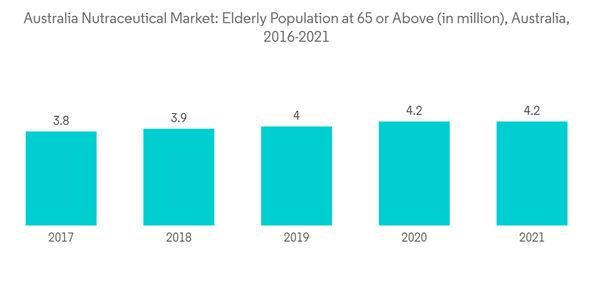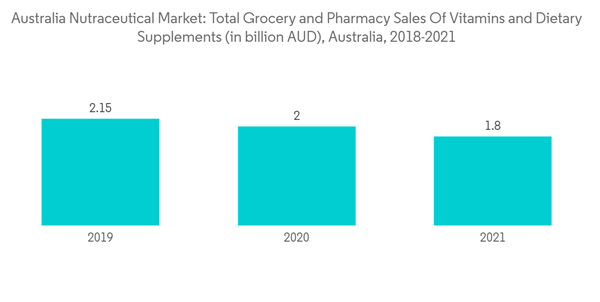The Australia Nutraceuticals industry is continually growing despite a dip in export revenue after the pandemic, as firms are innovating new immunity-based products and utilizing sustainable manufacturing techniques. After the pandemic, the country's people have become more aware of health issues, and the benefits of nutraceuticals like available breakfast cereals and snack bars have been on the rise. The market is increasing due to the launch of products containing probiotics and immune-boosting ingredients, which, in turn, have boosted its growth in the country.
Furthermore, the rising demand for nutraceuticals with medical benefits is one of the major factors driving the nutraceutical market growth. They contain a high concentration of bioactive compounds such as antioxidants, polyunsaturated fatty acids, and others that help manage health issues like obesity, CVD, cancer, cholesterol, arthritis, and diabetes. The growing preference for personalized nutrition is one of the critical nutraceuticals market trends, which may further stimulate market growth. The customized nutrition trend is growing, particularly among individuals with gut-related medical conditions where generic treatment is ineffective.
Australia Nutraceuticals Market Trends
Increasing Elderly Population boosting Nutraceuticals Market in the Country
As Australians age and face rising healthcare costs, many are considering the link between health and diet. The functional food (Nutraceutical) industry is seizing opportunities with product innovation and market expansion. In Australia, consumers aged 35 & above are purchasing vitamins, minerals, and other supplements at a higher rate than consumers under 25. Additionally, Australian consumers are inclined to a healthy lifestyle, privileging natural, organic, and functional products that are friendly to the environment and by fair trade standards. Companies developing applicable food products have begun marketing to specific demographics, such as the aging population, young adults, and mothers. Nutraceutical products may be especially relevant for preventing or delaying several age-related diseases, such as arthritis, cancer, metabolic and cardiovascular diseases, osteoporosis, cataracts, brain disorders, etc. The Australian nutraceutical market is expanding due to the rising prevalence of chronic diseases and increased use among older women.Functional foods such as cholesterol-reducing spreads, milk, and yogurt attract aging consumers. At the same time, parents are interested in products that may benefit their children's health, such as omega-3 and DHA-enriched products for brain development. Further, Australia's general rise in health consciousness was already boosting sales in this country, even before the pandemic arrived. At the same time, the aging of the Australian population offers fertile conditions for the further development of dietary supplements, particularly as consumers look to prevent the development of age-related diseases. This, in turn, is boosting the nutraceuticals market in the country.
Growing Demand for Dietary Supplements
Increasing demand for sports nutrition, on account of growing fitness trends and sports activities, and companies are launching new products that significantly impact the industry. For instance, in September 2022, Micro Mike in Australia introduced Protein Water, a clean and lean protein supplement with 12 grams of protein per serving, derived mainly from hydrolyzed pea protein peptides. Owing to suitable demographics, such as the increasing aging population and costs of healthcare, the preference for dietary supplements is also growing tremendously. Due to the rising number of personalized online systems available to consumers free of charge, manufacturers and retailers are beginning to offer free access to wellness tools, creating a customized vitamin list based on a consumer's specific conditions and needs. The major food groups that saw the greatest increase in dietary energy per capita per day between 2020-2021 were Dairy & meat substitutes rose 12.3% and Snack foods rose 2.3% according to the Australian Bureau of Statistics. In order to accommodate the rising demand, producers are developing new categories of dietary products. According to the Blackmores Annual Reports, the total grocery and pharmacy sales of vitamins and dietary supplements in Australia were AUD 1.8 billion in 2021. The growing prevalence of chronic diseases and advantages associated with botanical drugs over synthetic drugs, such as being safer with no adverse side effects and affordability, are driving the growth of this segment.Australia Nutraceuticals Industry Overview
The Australian nutraceutical market is fragmented, with global and local players. Key players are focusing on social media platforms and online distribution channels for their online marketing and branding of their products to attract more customers. The platform has proved beneficial for players and newcomers since the audience size is vast, and discounted offerings make the platform more competitive than retail; Companies are focusing on meeting consumer demands through product innovations, expansions, and mergers and acquisitions. The key players in the market are Kellogg Australia Pty. Ltd, Herbalife Australia, General Mills Australia Pty. Ltd, Amway Australia, and Nestle Australia Ltd.Additional Benefits:
- The market estimate (ME) sheet in Excel format
- 3 months of analyst support
This product will be delivered within 2 business days.
Table of Contents
Companies Mentioned (Partial List)
A selection of companies mentioned in this report includes, but is not limited to:
- Herbalife Australia
- Kellogg (Aust.) Pty. Ltd
- General Mills Australia Pty. Ltd
- PepsiCo Australia & New Zealand
- Nestle Australia Ltd
- Pure Harvest Smart Farms Ltd.
- Remedy Drinks
- Frucor Suntory
- Health & Happiness (H&H) International Holdings Ltd
- Pharmacare Laboratories Pty Ltd
- Bayer AG
- GlaxoSmithKline Plc
Methodology

LOADING...










